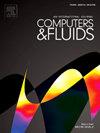Unsupervised extraction of rotational Lagrangian coherent structures
IF 2.5
3区 工程技术
Q3 COMPUTER SCIENCE, INTERDISCIPLINARY APPLICATIONS
引用次数: 0
Abstract
Lagrangian coherent structures (LCSs) are widely recognized as playing a significant role in turbulence dynamics since they can control the transport of mass, momentum or heat. However, the methods used to identify these structures are often based on ambiguous definitions and arbitrary thresholding. While LCSs theory provides precise and frame-indifferent mathematical definitions of coherent structures, some of the commonly used extraction algorithms employed in the literature are still case-specific and involve user-defined parameters. In this study, we present a new, unsupervised extraction algorithm that enables the extraction of rotational LCSs based on Lagrangian average vorticity deviation from an arbitrary 3D velocity field. The algorithm utilizes two alternative methods for the identification of the LCS core (ridge): an unsupervised clustering method and a streamline-based method. In a subsequent step, the ridge curve is parametrized through a pruning procedure of minimum spanning tree graphs. To assess the effectiveness of the algorithm, we test it on two cases: (i) direct numerical simulations of forced homogeneous and isotropic turbulence and (ii) three-dimensional Particle Tracking Velocimetry experiments of a turbulent gravity current.
旋转拉格朗日相干结构的无监督提取
拉格朗日相干结构(lcs)由于能够控制质量、动量或热量的传递而在湍流动力学中发挥着重要的作用。然而,用于识别这些结构的方法通常基于模糊的定义和任意阈值。虽然lcs理论为相干结构提供了精确的、与框架无关的数学定义,但文献中使用的一些常用提取算法仍然是针对具体情况的,并且涉及用户定义的参数。在这项研究中,我们提出了一种新的无监督提取算法,该算法能够基于任意三维速度场的拉格朗日平均涡度偏差提取旋转lcs。该算法利用两种替代方法来识别LCS核心(脊):一种无监督聚类方法和基于流线的方法。在接下来的步骤中,山脊曲线通过最小生成树图的修剪过程进行参数化。为了评估该算法的有效性,我们在两种情况下进行了测试:(i)强迫均匀和各向同性湍流的直接数值模拟和(ii)湍流重力流的三维粒子跟踪测速实验。
本文章由计算机程序翻译,如有差异,请以英文原文为准。
求助全文
约1分钟内获得全文
求助全文
来源期刊

Computers & Fluids
物理-计算机:跨学科应用
CiteScore
5.30
自引率
7.10%
发文量
242
审稿时长
10.8 months
期刊介绍:
Computers & Fluids is multidisciplinary. The term ''fluid'' is interpreted in the broadest sense. Hydro- and aerodynamics, high-speed and physical gas dynamics, turbulence and flow stability, multiphase flow, rheology, tribology and fluid-structure interaction are all of interest, provided that computer technique plays a significant role in the associated studies or design methodology.
 求助内容:
求助内容: 应助结果提醒方式:
应助结果提醒方式:


